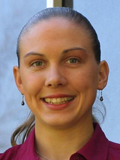Visiting Researchers
 |
Institute |
Stanford University |
Title |
Post-doctoral Researcher | |
Country |
U.S.A. | |
Period of Stay |
2008/09/15 - 2008/12/15 | |
Research Theme |
Deformation of earthquakes and volcanoes using InSAR and GPS | |
Host Researcher |
Teruyuki KATO |
During my post-doc at ERI I studied Miyakejima volcano using data from the L-band Radar instrument ALOS/PALSAR, which was launched in 2006. Although it has been several years since Miyakejima’s large dike intrusion and caldera collapse in 2000, the ALOS instrument was able to detect deformation indicating subsidence within Miyakejima’s summit caldera. Four coastal GPS sites were not able to detect this localized deformation. While modeling efforts are still in progress, the subsidence is possibly due to cooling and contracting of the central chamber that supplied the magma to the 2000 intrusion. Although C-band radar data significantly decorrelate on the forested flanks of Miyakejima, C-band observations are also being investigated for potential observations of the caldera area between 2000 and the beginning of ALOS/PALSAR observations in 2006.
I participated in two small field projects while in Japan. The first trip was to help my host, Kato-sensei, upgrade of some permanent GPS sites in Shizuoka Prefecture to instruments capable of recording 1 Hz GPS data. These instruments supplement the nationwide GeoNet array stations to study the complex deformation near the edge of the Nankai subduction zone, and perhaps to record the next Tokai earthquake. The second field trip was to help collect campaign GPS instruments in Niigata prefecture with a group of about 30 professors and students from several Japanese universities. These instruments had been deployed as the first of five yearly surveys to study an area of central Japan that is subject to very high strain rates.
I also had the opportunity to attend several meetings including those of the Geodetic Society of Japan and the Asian Seismological Commission. Both of these meetings provided a great opportunity to meet Japanese colleagues, and to learn more about the breadth of research being conducted in Japan.
